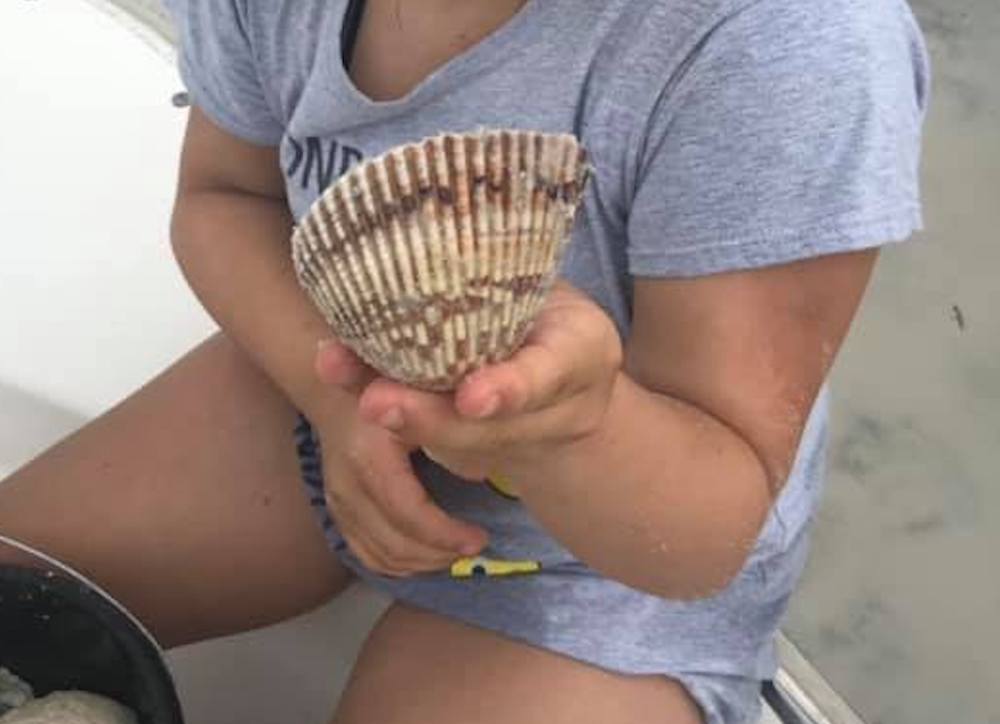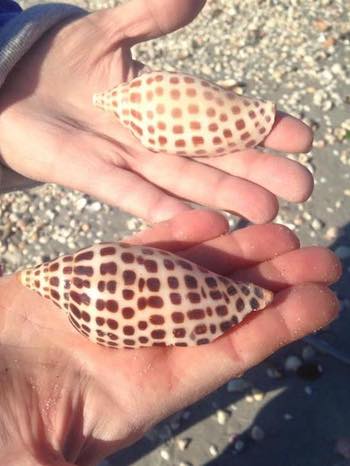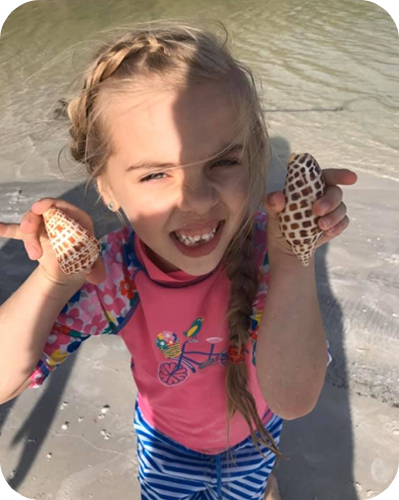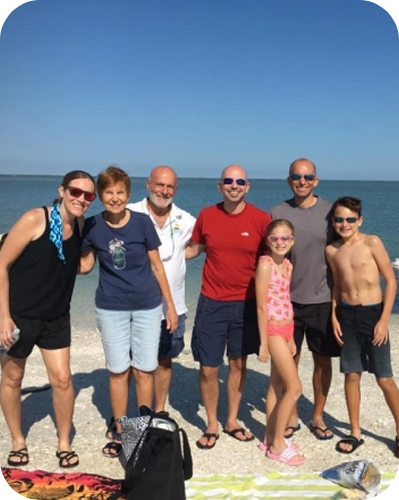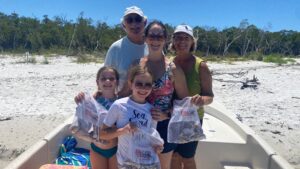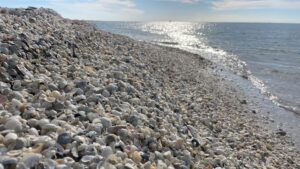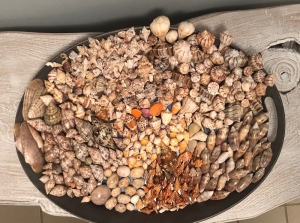Are you looking for a way to warm the cockles of your heart while you dream about shelling on Marco Island in Florida? First, it might help to understand what a cockle is, and why your heart has one!
The expression “cockles of your heart” comes from the shape of cockle shells, which are large, striking clamshells that you can find when you explore the local beaches. Your own cockles, or ventricles, might very well swell with warmth when you come across one of these marvels on an expedition with Sand Dollar Shelling! But where do they come from, and what sort of creatures make these lovely marvels their home?
Finding a beautiful, colorful cockle shell on the beach is often the highlight of a successful shelling adventure. Each one is a unique, fan-shaped specimen, and nobody else in the world will have one quite like yours! Keep reading to learn everything there is to know about these treasures of the deep so you can prepare to bring some home on your next Marco Island odyssey!
What Is a Cockle Shell?
What pops into your mind when you picture the platonic ideal of a seashell? Odds are good that you’re picturing something that looks like a cockle shell! A cockle shell is a fan-shaped bivalve shell with smooth, radial ribs, often featuring subtle, earth-tone stripes.
Cockle Shells Are Bivalve Shells
A bivalve shell is any shell featuring two halves, or valves, that connect to a central hinge, called a ligament. The shell forms the exoskeleton of the cockle clam, which lives inside throughout its life. It’s not uncommon to find a single valve on its own – but part of the magic of these shells is knowing that its perfect double is out there in the world somewhere!
If you’ve very lucky, you might even find the complete shell intact, with both valves present! Be careful if you find a cockle shell closed up tight, however! There might be a cockle inside, and they don’t smell great when they begin rotting!
Cockle Shells Can Be Large
You can find cockle shells in a variety of colors, including red, brown, and yellow. The Atlantic Giant Cockle, which makes its home in the waters around the panhandle, has one of the largest shells of any clam in the sea. These large cockle shells can be up to six inches in size!
Cockle Shells Are Easy to Find
It isn’t only their size that makes these beauties easy to spot on the soft, white sands of the Marco Island beach. The cockles that make their homes in these shells enjoy a simple life near the surface of the ocean. After a good tide, you can often find cockles and their shells right on the sand.
Sometimes, however, you may have to put a little elbow grease into your search! Your best bet is to go hunting during low tide using a rake rather than a shovel or trowel. Sometimes you might even find one near the surface by stepping on one and listening for a telltale clunking sound!
The location and abundance of these shells make them one of the easiest and most satisfying finds for children and families. If you don’t have your heart set on finding an elusive Junonia shell, you can have a satisfying day of cockle hunting without breaking a sweat!
BOOK YOUR SHELLING TOUR!
Are You Looking For A Guided Seashell Finding Tour in Southwest Florida? Book With Sand Dollar Shelling!
What Are Cockles?
Every seashell that you find washed up on the Marco Island beach was once home to a living creature. In the case of cockle shells, that creature was – you guessed it – a cockle clam! A clam describes any variety of bivalve mollusk.
Cockles are clams that belong to the family Cardiidae, and you can find them in oceans and bodies of water all around the world. In fact, there are at least 250 distinct species of cockles known to science! If you were to visit a natural history collection, you could spend an entire day investigating cockle shells alone!
These ocean dwellers can be as small as one centimeter (that’s less than half an inch)! A giant cockle shell might grow as large as fifteen centimeters, or about six inches.
How the Cockle Gets Its Shell
A cockle clam is born as larvae and quickly develops its distinctive shell early in life. The color of a cockle’s unique shell comes from its environment, particularly its food source. The warmer the ocean is, the more diverse the food source, and the more colorful the cockle’s shell will appear!
What Cockles Eat, and Who Eats Cockles
In the deep blue sea, it’s eat or be eaten! Cockles enjoy a diet made up of microscopic ocean organisms, which it filters through its shell. On the other end, the cockle is a favored treat of seastars, bottom-feeders, and shorebirds like seagulls… and humans!
Yes, when you order delicious Baked Clams Oreganata at your favorite restaurant, you are enjoying the briny taste of cockles! The shells on your plate will be the same shells that you can find on your shelling excursion. They won’t be as unique, however, because the clams you enjoy at restaurants are more likely to have come from a dedicated farm.
Cockles in Action
You might imagine cockles as fairly sedentary creatures, but their soft bodies are full of muscle! Imagine that their entire body is one big, slimy tongue! While they spend much of their time drifting in the surf or burrowing in sand or mud, they are capable of much more than that!
Each cockle can use its body like a foot. It kicks and kicks, either to burrow deeper into the sand or to launch itself off into the sea. Sometimes, while relaxing on the surface of the sand, a cockle will stick out its long tongue-foot and flip itself over to adjust its position!
Cockles are capable of opening and closing their shells. A distinct feature of a cockle’s unique shell is its ability to close completely. This helps protect the shell’s squishy resident from hungry predators.
Common Types of Cockle Shells
Not every species of cockle makes its home in the Atlantic ocean, but some of the most striking specimens are currently burrowing on our very own beaches! There are several distinct types of giant cockles in the wet sand along the Atlantic coast.
A few of the most common species include:
- The Great Heart Cockle
- The Florida Prickly Cockle
- The Atlantic Strawberry Cockle
- The Yellow Cockle
You are likely to find these species when you go out for a shelling excursion with Sand Dollar Shelling. They are abundant on Marco Island and the surrounding beaches.
The Great Heart Cockle
The Great Heart Cockle is also known as the Atlantic Giant Cockle – they are different names for the same species!
They are stunning and exciting find because of their distinctive heart shape! You can see the hidden heart when you turn an intact heart cockle on its side, with the opening facing downward. In profile, the two halves form a perfect Valentine’s Day heart shape!
Shelling enthusiasts aren’t the only ones who love The Great Heart Cockle! These marine bivalves sometimes house tiny crabs within the walls of their thick, protective shells.
These are the big boys! When you’re on the hunt for large cockle shells, you’re probably looking for the Atlantic Giant Cockle. They can be up to six inches across, and feature between thirty and forty radial ribs from edge to edge.
Interestingly, a full-grown Great Heart Cockle is approximately the same size as an adult human heart.
The Florida Prickly Cockle
The Flordia Prickly Cockle is everywhere along the shores of the Southwestern part of Florida! The very edges of these shells tend to have a spiny appearance than other cockle shells you might find. This is how these common clams get their name!
If you are on the hunt for something special, you might seek out an albinistic prickly cockle. These unique creatures are completely white in color and are popular with shell collectors.
If you’re a lover of itty bitty shells, you’ll have a blast hunting for prickly cockles on your shelling adventure! The Florida Prickly Cockle can sometimes be less than half an inch from end to end, making them the size of a fingernail – or smaller!
The Atlantic Strawberry Cockle
The Atlantic Strawberry Cockle lives near the reefs off the Florida coast. While they’re abundant out there, they’re a little bit of a rarer find on the beach. They tend to have reddish, rust-colored stripes and a narrower shape than other local species.
The Yellow Cockle
The Yellow Cockle (sometimes the Yellow Prickly Cockle) has a distinctive circular shape that makes it appealing to collectors. Unsurprisingly, they tend to range in color from yellow to orange, with occasional pops of red. Like the prickly cockle, they have spiny protrusions on their outer edges that can help distinguish them from other, similar species.
Rarer Types of Cockle Shells
In total, there are about eight species of cockles that you are likely to find on Florida’s beaches. While the above four are the most common, there are a few types that are more elusive and desirable for collectors!
These rarer cockle varieties include:
- The Spiny Paper Cockle
- The Common Egg Cockle
- The Painted Egg Cockle
- Morton’s Egg Cockle
When you take a shelling tour with local guides from Sand Dollar Shelling, there is a much higher than average chance of locating one of these uncommon shells. Our guides do more than just transport you to Marco Island. They’ll show you the tips and techniques that can help you spot a true gem!
The Spiny Paper Cockle
The Spiny Paper Cockle is also sometimes called the Square Paper Cockle. They are small and delicate, rarely growing beyond two inches from edge to edge. You can sometimes find Spiny Paper Cockles with pastel markings in pink, light purple, and orange.
These shells are thin and delicate, and it can be challenging to find one intact on the beach. Contrary to their name, they aren’t square. They take on the same gentle fan shape as the majority of local cockle shells and feature about twelve radials on average.
The Common Egg Cockle
This shell is unique in that it lacks radial ribs. Instead, it’s almost entirely smooth, not unlike an egg! Also like an egg, it tends to come in an off-white eggshell color, though some have slight patterns.
These shells are also difficult to find intact due to their delicate structure – something else they have in common with eggshells! These smooth cockle shells can grow to up to three inches in size.
The Painted Egg Cockle
The Painted Egg Cockle has the same texture and shape as the Common Egg Cockle but tends to feature unique coloration. They often feature gorgeous gradients that look like watercolor paint.
Morton’s Egg Cockle
These rare shells are also unique due to their lack of radial ribs. They differ from the common or painted egg cockle due to their distinctive brownish bands. These stripes circle the entire shell from top to bottom, adding a touch of unique beauty to these smooth and delicate treasures.
Collect Cockle Shells With Sand Dollar Shelling
The cockle clam is a fascinating creature whose gorgeous, striated shell makes for a unique souvenir after a satisfying day of shelling! Best of all, the Atlantic Giant Cockle makes the ocean around Marco Island its home! When you head out to the beach with one of our experienced guides, you are sure to find these large, perfect shells by the bucketful!
Are the cockles of your heart warm enough yet? When you book a shelling tour with Sand Dollar Shelling, you’re certain to experience a burst of warmth, knowing these gorgeous giant cockle shells will soon be yours! Book your tour now and you’ll be one step closer to unearthing a beauty!

